Full-Arch Implant Restorations: Improving Patients’ Lives Over the Short and Long Term
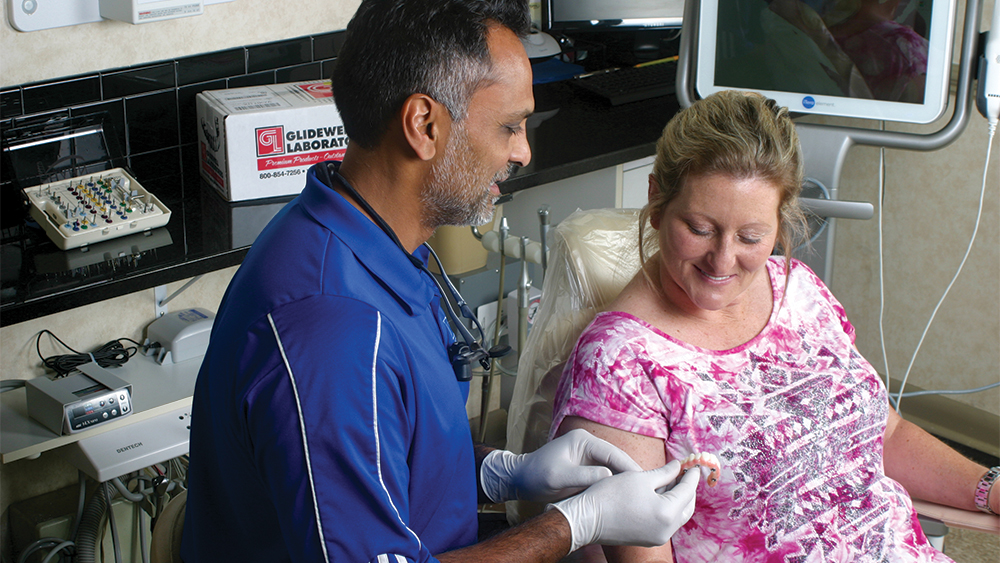
Note: The Hahn Tapered Implant System is now known as the Glidewell HT Implant System
Doctors who perform implant therapy in full-arch indications not only restore form and function, but also improve the quality of life for the edentulous patient. Whether requesting treatment for ill-fitting, poorly functioning dentures or a permanent solution for terminal dentition, these patients commonly suffer from discomfort, diminished chewing capability, and low self-esteem as a result of their condition. By providing a fixed implant prosthesis, we can positively impact these patients’ lives with a restoration that mimics the appearance and function of natural teeth while minimizing bone loss.1,2
Immediate provisionalization after implant placement is particularly beneficial to the fully edentulous patient and instantly addresses many of the problems associated with edentulism or untreatable dentition. Receiving fixed teeth on the day of surgery is appealing to patients because it allows for the immediate restoration of function, avoids challenges related to removable temporary dentures, reduces the number of surgical appointments, and establishes a template for the eventual full-arch restoration.
Because this approach is indicated only in the presence of high initial implant stability, many practitioners have refined their techniques and surgical armamentarium to increase the likelihood that immediate loading can be safely performed. This includes the use of implants with an aggressive thread design to maximize primary stability and the odds that an immediate provisional appliance can be delivered.
During the restorative phase of treatment, dentists are taking advantage of the CAD/CAM process to fine-tune prosthetic designs with a remarkable degree of precision, providing the patient with a confident smile. Clinicans can visualize the ideal prosthetic outcome through dental CAD software, confirm that design in physical form via the PMMA provisional implant prosthesis, and make any final adjustments before the final restoration is produced in durable, esthetic BruxZir® Solid Zirconia.
CASE REPORT
A patient sought treatment for advanced caries and periodontal disease in the maxillary arch, which had become painful and compromised her oral function. Although her remaining mandibular teeth also required replacement, she couldn’t afford to restore both arches at once and, like most patients, she placed a higher priority on her maxillary arch because of her esthetic needs. Following a discussion of treatment options, the patient requested a fixed restoration and was opposed to a removable appliance. At the surgical appointment, her maxillary teeth were extracted and Hahn™ Tapered Implants (Glidewell Direct; Irvine, Calif.) were placed. Sufficient primary stability was established for an immediate provisional appliance, which satisfied the patient’s request to leave the surgical appointment with a fixed restoration in place. After five months of healing and confirmation of the prosthetic design with a PMMA provisional, function, esthetics and quality of life were restored with a BruxZir Full-Arch Implant Prosthesis.
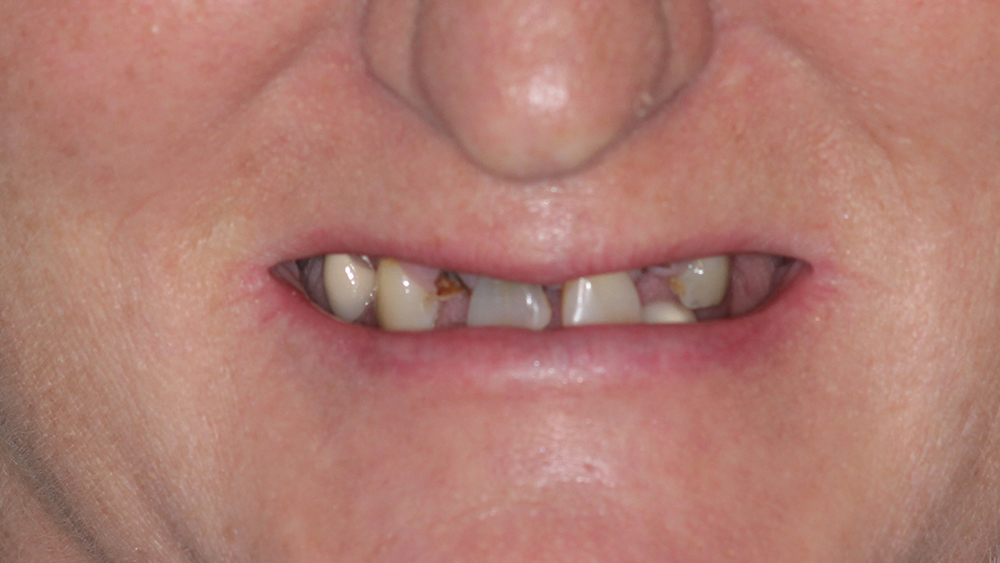
Figure 1: Preoperative extraoral image of the patient, who presented with terminal dentition and poor esthetics and function. The patient requested a fixed upper restoration and did not want to wear a removable appliance at any point during treatment. A BruxZir Full-Arch Implant Prosthesis was selected for maximum durability, optimal esthetics, and the ability to refine the prosthetic design with the PMMA provisional implant prosthesis.
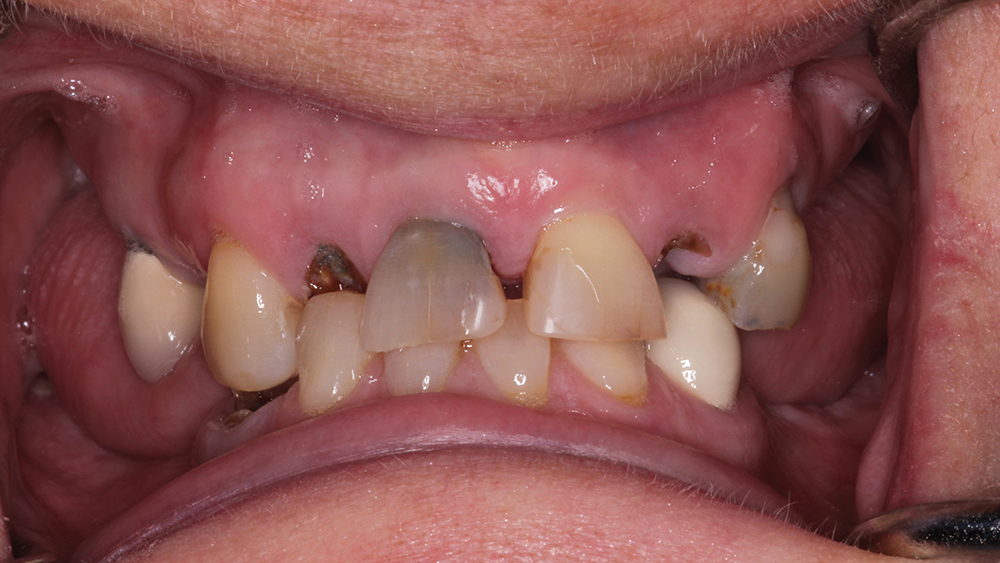
Figure 2: Intraoral view of maximum intercuspation shows the preoperative state of the patient’s teeth, which were compromised by severe decay, periodontal breakdown, hyper-eruption and a collapsed bite. The patient agreed to a treatment plan in which her upper teeth would be extracted and immediately replaced with implants — an approach that shortens the duration of treatment while producing success rates that compare favorably with delayed implant placement.3,4
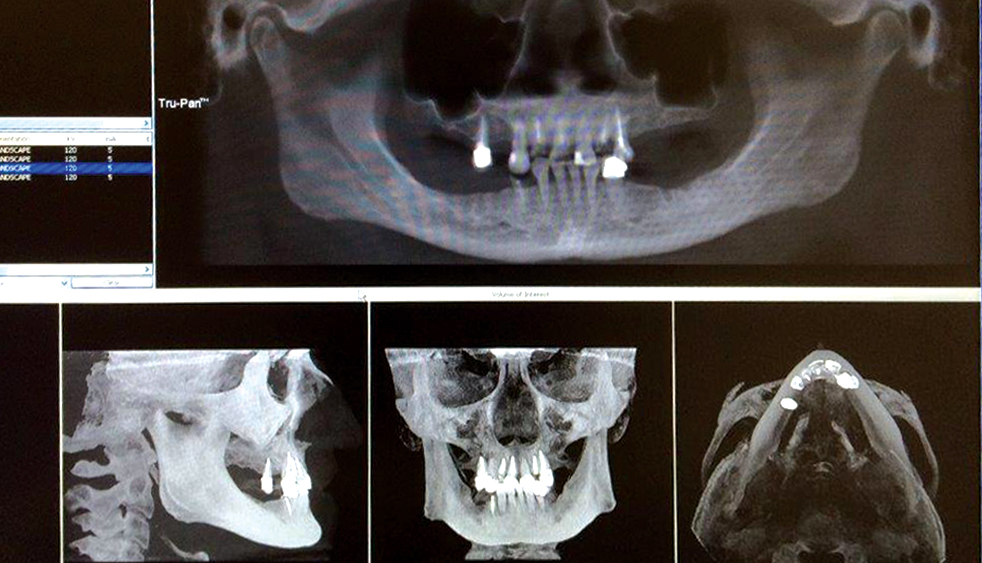
Figure 3: A CBCT scan confirmed adequate bone levels for extraction with immediate implant placement. The scan also helped determine how many implants to place and their ideal positioning. The placement of eight implants in this case would help distribute functional forces among the implants and minimize transverse loads, which is especially helpful in the maxilla, where the bone quality tends to be lower.
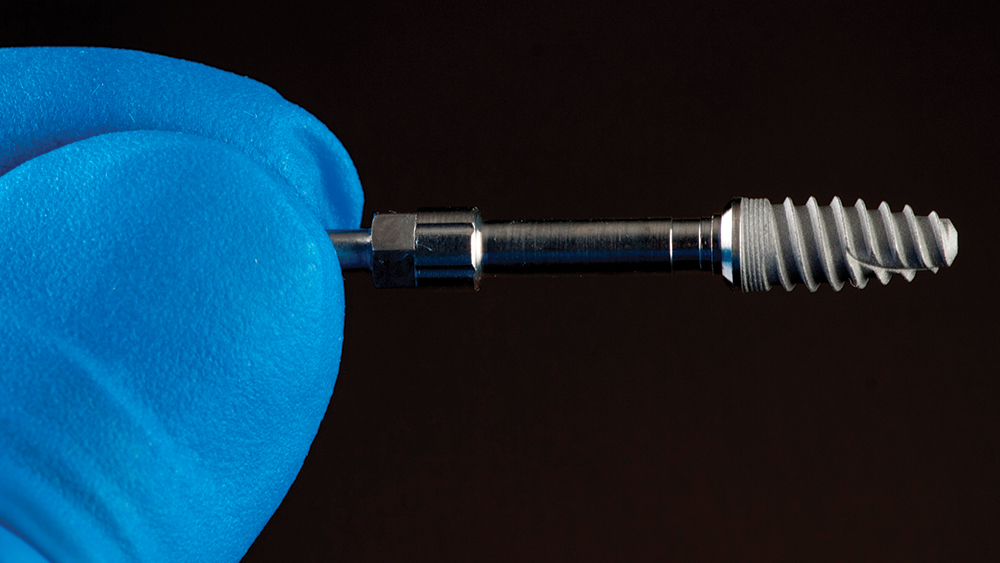
Figures 4a, 4b: The maxillary teeth were extracted and alveoplasty was performed. Then, osteotomies were created for the Hahn Tapered Implants, the sharp threads of which helped maintain proper position against the palatal wall during insertion. This positioning is important both to situate the implants behind the incisal edges of the eventual prosthesis and to avoid the fragile buccal plate. Multi-unit abutments were connected to the implants, correcting for divergent angulation among the implants.
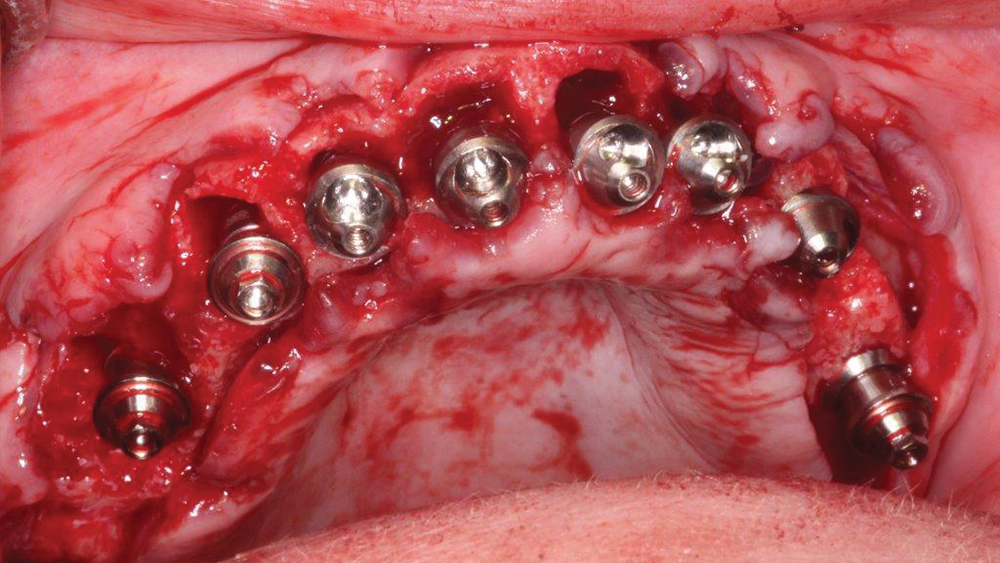
Figures 4a, 4b: The maxillary teeth were extracted and alveoplasty was performed. Then, osteotomies were created for the Hahn Tapered Implants, the sharp threads of which helped maintain proper position against the palatal wall during insertion. This positioning is important both to situate the implants behind the incisal edges of the eventual prosthesis and to avoid the fragile buccal plate. Multi-unit abutments were connected to the implants, correcting for divergent angulation among the implants.

Figure 5: Because the Hahn implants achieved the high primary stability needed for immediate loading, a denture that was fabricated prior to the surgical appointment was converted into an implant-supported provisional restoration, meeting the patient’s desire to leave the surgical appointment with fixed teeth. First, temporary cylinders were connected to the multi-unit abutments and the immediate denture was tried in. Then, a series of burs was used to create holes for the temporary cylinders, which were used to attach the fixed provisional denture to the implants.

Figure 6: Next, the immediate denture was seated over the temporary cylinders in the patient’s mouth. Quick Up, a self-curing denture relining material (VOCO America, Inc.; Indian Land, S.C.), was used to affix the temporary cylinders to the prosthesis. After unscrewing the temporary cylinders, the denture was removed. The temporary cylinders were trimmed to rest beneath the occlusal plane, and the posterior teeth of the appliance were removed to eliminate cantilevers and minimize functional stresses on the posterior implants during healing.
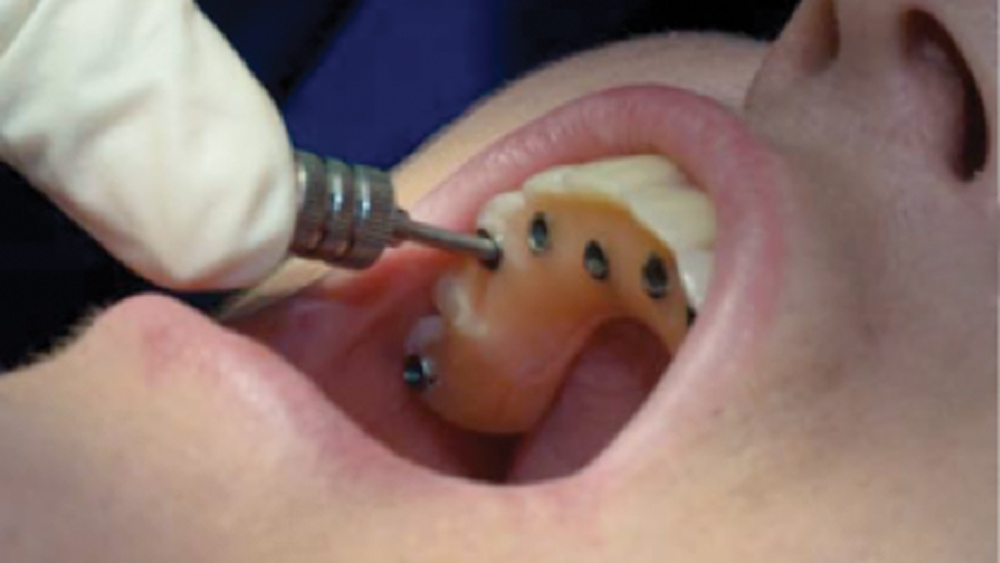
Figures 7a, 7b: With fabrication of the palateless, horseshoe-shaped provisional complete, the appliance was seated over the Hahn Multi-Unit Abutments, the prosthetic screws were tightened and the screw access holes were sealed with Capture® VPS Impression Material (Glidewell Direct; Irvine, Calif.). The patient was extremely pleased to receive a fixed provisional denture on the day of surgery, which immediately restored function and personal confidence. Additionally, wearing the appliance during healing afforded the opportunity to identify any functional or esthetic concerns prior to the restorative phase of treatment.
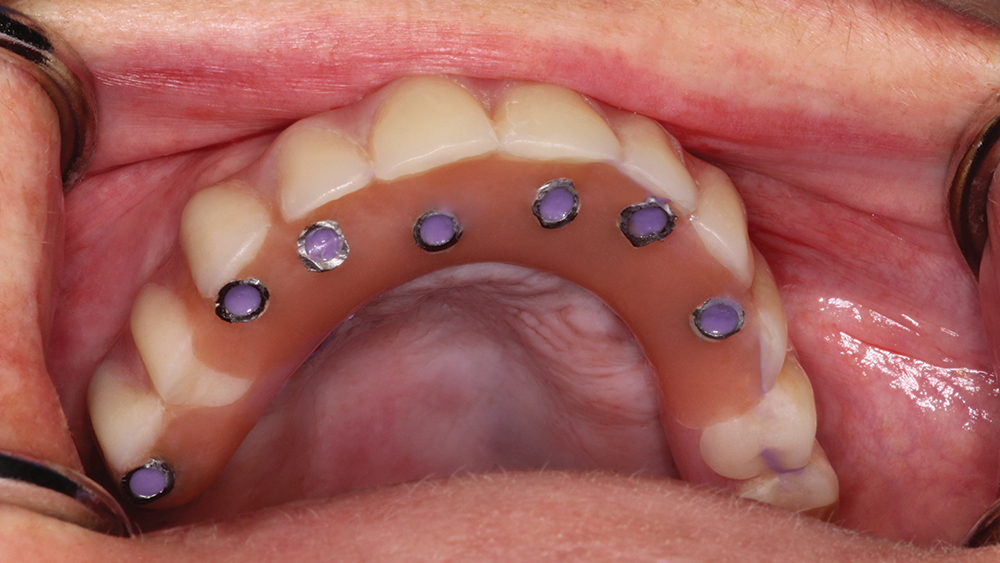
Figures 7a, 7b: With fabrication of the palateless, horseshoe-shaped provisional complete, the appliance was seated over the Hahn Multi-Unit Abutments, the prosthetic screws were tightened and the screw access holes were sealed with Capture® VPS Impression Material (Glidewell Direct; Irvine, Calif.). The patient was extremely pleased to receive a fixed provisional denture on the day of surgery, which immediately restored function and personal confidence. Additionally, wearing the appliance during healing afforded the opportunity to identify any functional or esthetic concerns prior to the restorative phase of treatment.
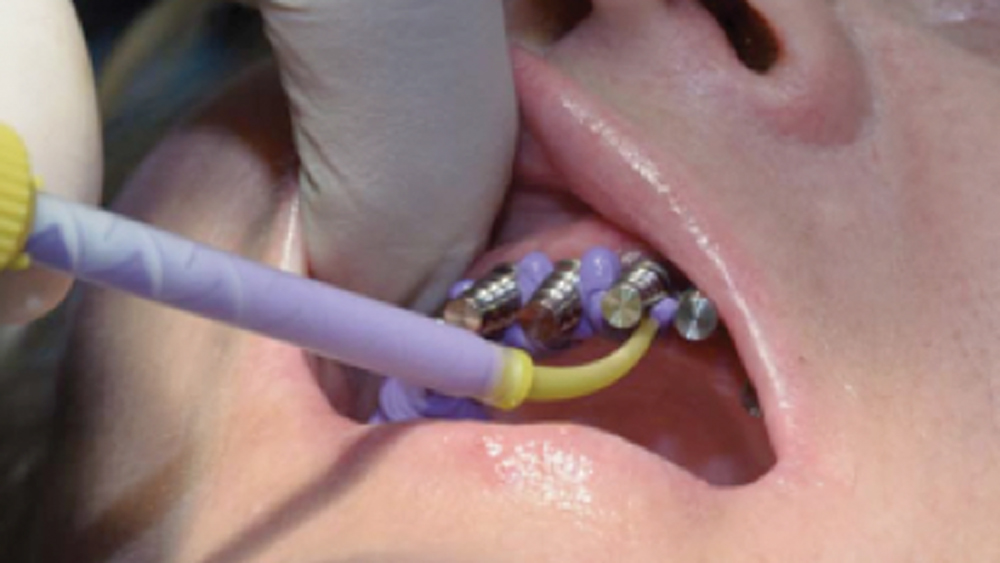
Figure 8: After five months of healing, excellent soft-tissue health and implant stability were observed. A preliminary impression was made with open-tray transfer copings in place. The full-arch impression was submitted to the lab along with a duplicate of the provisional denture, which served as a template for the restoration, with confirmed incisal edge positions, teeth shape, midline, intaglio surface and phonetics. Instructions for modifications to the prosthetic design were also provided to address minor complaints the patient had with the form and function of the provisional.
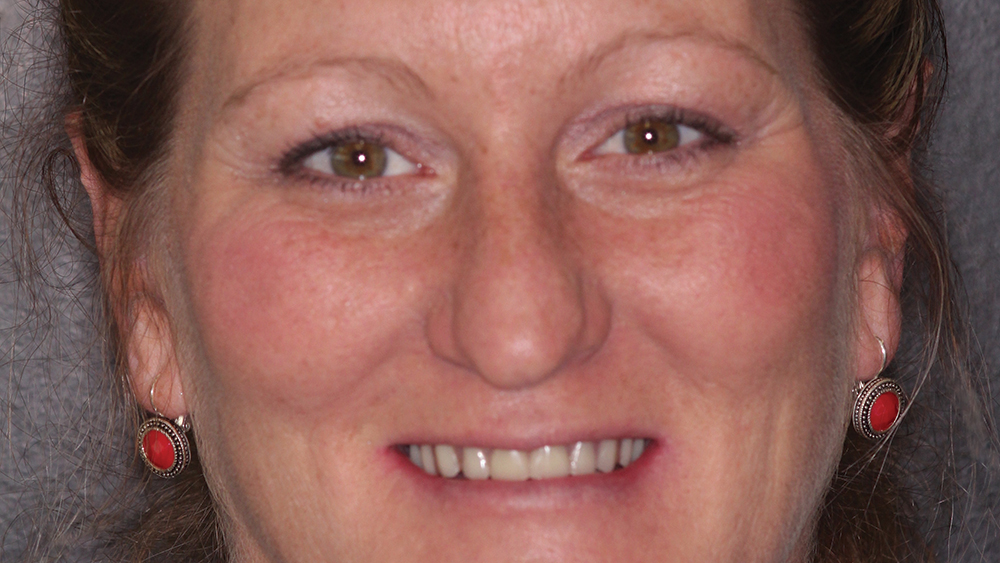
Figure 9: The patient’s jaw relationship was recorded, and the lab fabricated a wax setup for try-in. With the setup in place, the midline, teeth arrangement, incisal edge positions, lip support, esthetics and phonetics were evaluated, and minimal adjustments were required because the design was guided by the fixed provisional denture, with which the patient was quite happy. A final impression was made using the lab-provided custom tray and implant verification jig, which ensured the implant positions were accurately represented in the master cast.

Figure 10: The wax setup and master cast were scanned, and dental CAD software was utilized to create the initial design for the BruxZir Full-Arch Implant Prosthesis. A provisional implant prosthesis was milled from PMMA, a material that is easily adjusted to accommodate additive or substractive alterations. The PMMA provisional implant prosthesis is essential in finalizing the prosthetic design and offers the opportunity to fine-tune the occlusion, ensure a cleansable intaglio surface, and make any other final adjustments before the restoration is fabricated from solid zirconia.
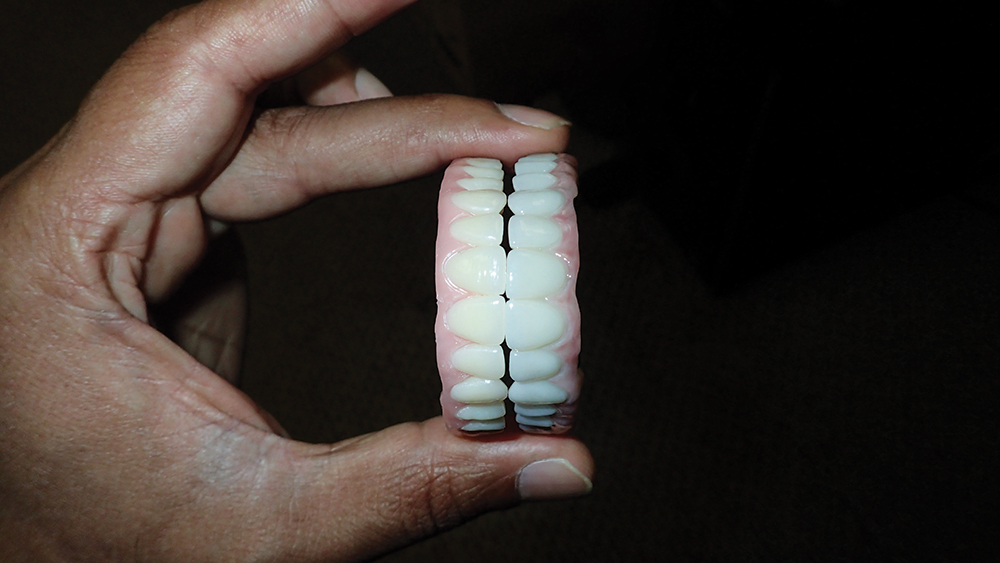
Figure 11: Side-by-side of PMMA and final wax setup illustrates how the provisional implant prosthesis is virtually a replica of the approved prosthetic design. Any adjustments after this point are typically occlusal in nature, and modifications made to the PMMA are carried over to the final restoration with precision via the CAD/CAM copy-mill process.

Figure 12: The patient’s immediate fixed provisional denture was removed and the complete molar-to-molar provisional implant prosthesis was tried in, providing a final opportunity to verify the design. The patient was satisfied with the esthetics, phonetics and function of the provisional implant prosthesis, although minor occlusal alterations were made. The opportunity to fine-tune occlusion with PMMA is a significant advantage, as the denture teeth of a wax setup lack the stability to precisely capture occlusal adjustments. After a one-week trial period, the doctor and patient approved the final design, and the PMMA appliance was removed and sent to the lab for fabrication of the solid zirconia restoration.
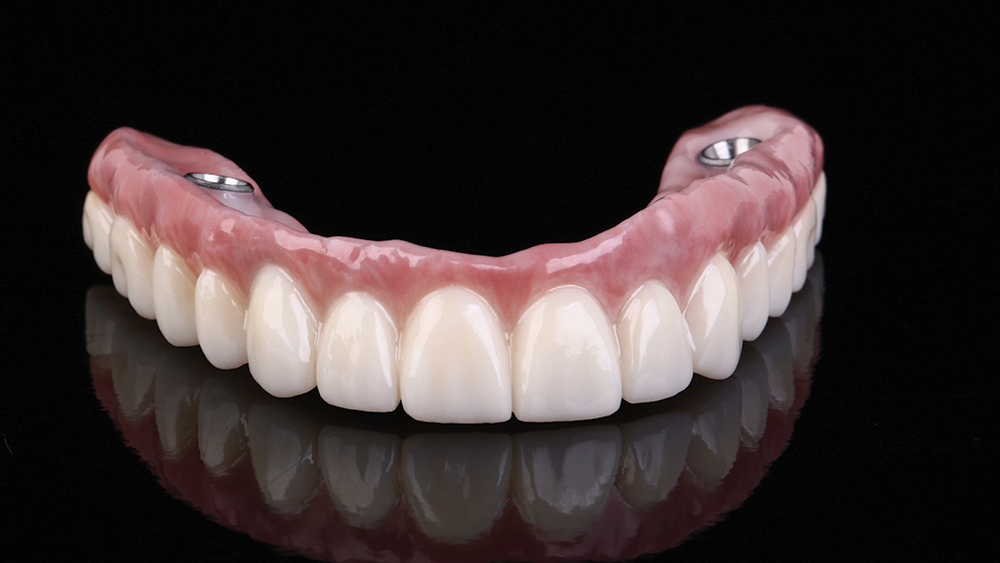
Figure 13: After scanning the PMMA provisional implant prosthesis so the occlusal alterations could be incorporated into the CAD design for the final prosthesis, the restoration was milled from a block of BruxZir Full-Strength Solid Zirconia. With an average flexural strength of 1,150 MPa, BruxZir Full-Strength provides maximum resistance to wear and fractures, eliminating the problem of having patients return to the office with a damaged acrylic hybrid denture.
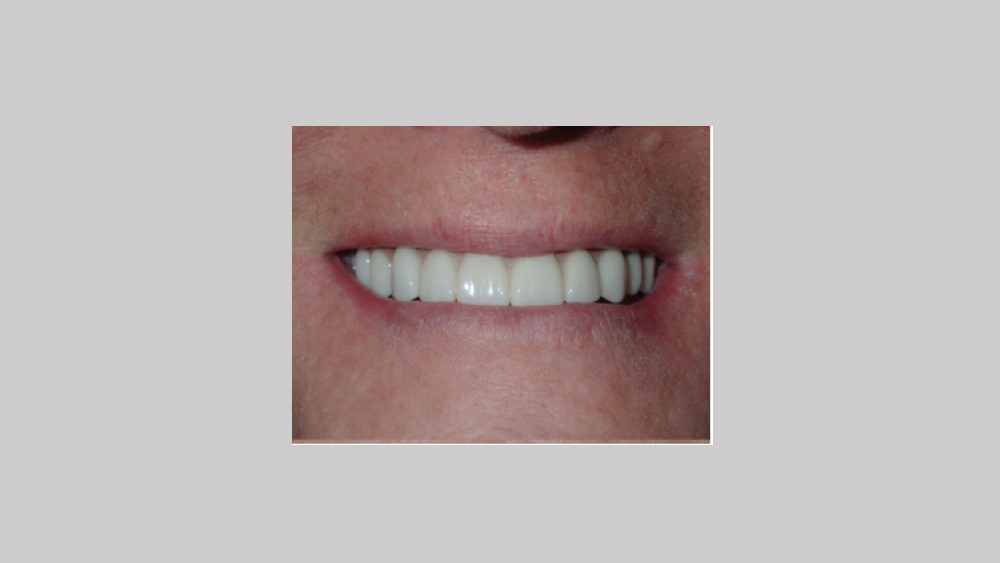
Figure 14: The monolithic zirconia full-arch implant prosthesis was delivered, established a precise fit and required zero adjustments. The patient, who had grown accustomed to the prosthetic design during the short trial period wearing the PMMA provisional, was delighted with the function and esthetics of the final restoration. The Hahn Tapered Implants, which helped facilitate proper positioning for the full-arch restoration and established the primary stability needed for immediate provisionalization, contributed to the predictable final outcome.
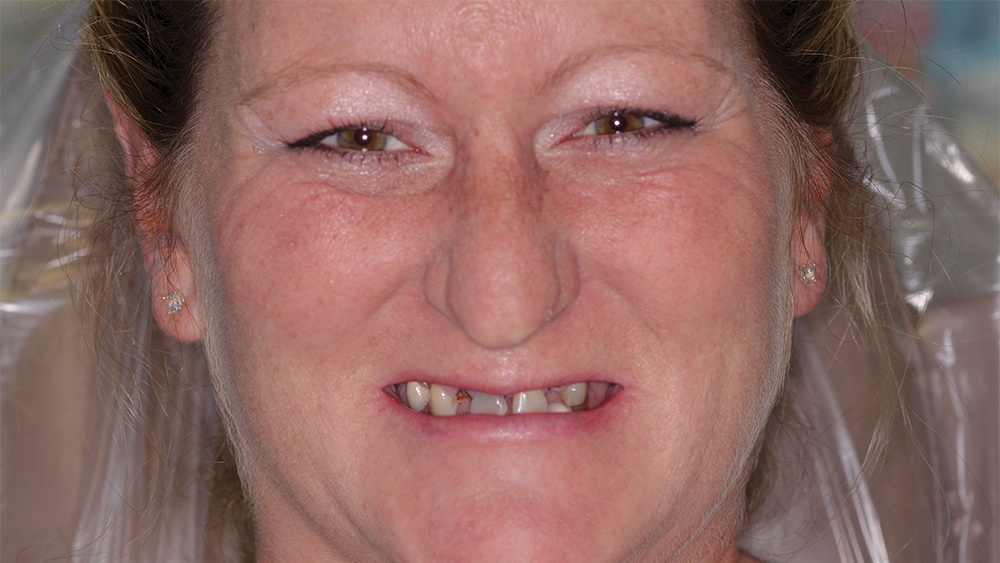
Figures 15a, 15b: Before-and-after images demonstrate the life-changing results of implant therapy combined with a BruxZir full-arch restoration, which transformed the patient from having severely compromised dentition to full function and a confident smile. Due to the high strength of the BruxZir Full-Arch Implant Prosthesis, the patient enjoys an excellent long-term prognosis, and she plans to eventually receive the same treatment for her mandibular arch.
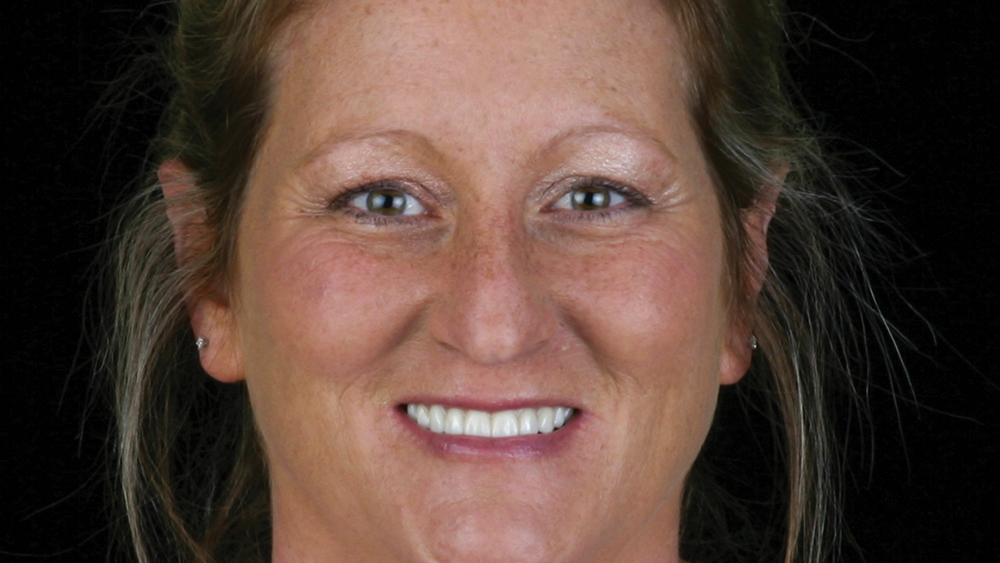
Figures 15a, 15b: Before-and-after images demonstrate the life-changing results of implant therapy combined with a BruxZir full-arch restoration, which transformed the patient from having severely compromised dentition to full function and a confident smile. Due to the high strength of the BruxZir Full-Arch Implant Prosthesis, the patient enjoys an excellent long-term prognosis, and she plans to eventually receive the same treatment for her mandibular arch.
- 1
- 2
- 3
- 4
- 5
- 6
- 7
- 8
- 9
- 10
- 11
- 12
- 13
- 14
- 15
- 16
- 17
- 18
Sufficient primary stability was established for an immediate provisional appliance, which satisfied the patient’s request to leave the surgical appointment with a fixed restoration in place.
CONCLUSION
The combination of tried-and-true surgical protocols and modern implant prosthetics has simplified the restoration of function for patients with debilitating dental conditions, and has improved what we can accomplish esthetically. With the aid of proper implant selection and positioning, high primary stability can be established, allowing for the delivery of an immediate provisional that affords instant relief for the patient and gives the clinician a head start on determining the optimal prosthetic design for the patient. This provides the opportunity to transform the oral health — and quality of life — of the fully edentulous patient on the day of surgery, while setting the stage for a predictable, long-lasting restoration.
References
- ^Jacobs R, Schotte A, van Steenberghe D, Quirynen M, Naert I. Posterior jaw bone resorption in osseointegrated implant-supported overdentures. Clin Oral Implants Res. 1992 Jun;3(2):63-70.
- ^Preciado A, Del Río J, Lynch CD, Castillo-Oyagüe R. Impact of various screwed implant prostheses on oral health-related quality of life as measured with the QoLIP-10 and OHIP-14 scales: a cross-sectional study. J Dent. 2013 Dec;41(12):1196-207.
- ^Covani U, Cornelini R, Calvo-Guirado JL, Tonelli P, Barone A. Bone remodeling around implants placed in fresh extraction sockets. Int J Periodontics Restorative Dent. 2010 Dec;30(6):601-7.
- ^Tealdo T, Menini M, Bevilacqua M, Pera F, Pesce P, Signori A, Pera P. Immediate versus delayed loading of dental implants in edentulous patients’ maxillae: a 6-year prospective study. Int J Prosthodont. 2014 May-Jun;27(3):207-14.


